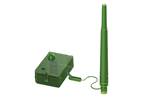iMFLUX Goes Royalty-Free and Transitions to Mainly R&D Role
By July, P&G will close the iMFLUX site and move to royalty-free licensing through injection-machine vendors and third-party retrofitters. An iMFLUX R&D team will continue to develop the technology.
Control screen shows the constant-low-pressure green curve for iMFLUX vs. the blue standard injection curve with its sharp pressure spike that is said to be the root of common molding problems. (Photo: iMFLUX)
Procter & Gamble is implementing a new 大象传媒 model for its iMFLUX subsidiary. By July, P&G plans to close the 200,000-ft2 iMFLUX site in Hamilton, Ohio, and the venture will assume mainly an R&D role with a “focused expert team within P&G that will continue to drive the technology forward and further innovate and collaborate with the industry to enable adoption of the iMFLUX technology,” according to Gene Altonen, iMFLUX chief technology officer, who will remain with the iMFLUX team.
Since 2017, iMFLUX has been promoting proprietary technology for low-constant-pressure injection molding that is said to resolve many of the difficulties with conventional injection that result in poor part quality and rejects, among other issues. Last October, iMFLUX became the first injection molding technology to receive Underwriters Laboratories (UL) verification for three claims: “iMFLUX delivers up to 15% energy savings, up to 4% part weight reduction and automatically adapts to a ±52% MFI material shift.”
Going forward, iMFLUX technology will be disseminated mainly through , some 16 of which have already partnered with iMFLUX to integrate its technology into new machines, and with various other third-party vendors who retrofit iMFLUX technology for existing presses. iMFLUX also has a in Moldex3D and seven , including the American Injection Molding (AIM) Institute, U. Mass. Lowell, Ferris State University and Penn State Behrend. Another new element in the iMFLUX 大象传媒 model is implementation of royalty-free licensing, which Altonen says will “allow machinery OEMs to use the technology without the encumbrance of a complex 大象传媒 model. We believe going directly to the OEM and offering a simple, royalty-free licensing agreement should drive an incentive to do so”
Related Content
-
Got Streaks or Black Specs? Here’s How to Find and Fix Them
Determining the source of streaking or contamination in your molded parts is a critical step in perfecting your purging procedures ultimately saving you time and money.
-
Back to Basics on Mold Venting (Part 1)
Here’s what you need to know to improve the quality of your parts and to protect your molds.
-
Use These 7 Parameters to Unravel the Melt Temperature Mystery
Despite its integral role in a stable process and consistent parts, true melt temperature in injection molding can be an enigma. Learning more about these seven parameters may help you solve the puzzle.



